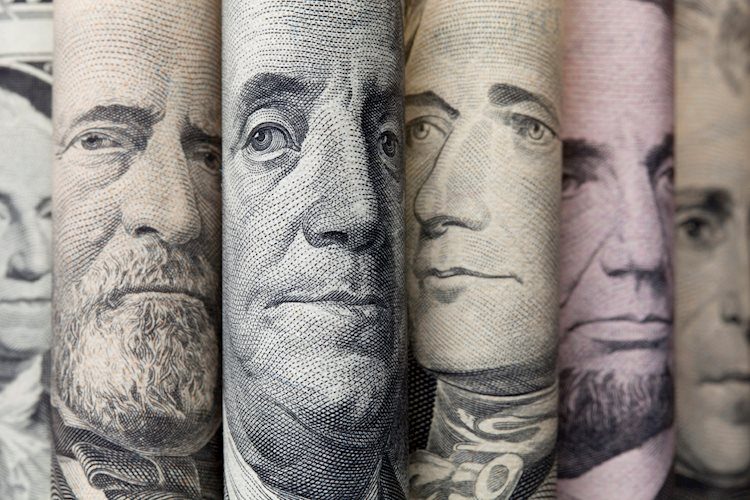- The DXY index first declined to 104.00 and then recovered to 104.40.
- The headline and core PPI cooled down in October, while US Retail Sales declined but were lower than expected.
- Investors seem to worry that strong economic activity data might weigh more than cooling inflation in the Fed’s eyes.
- The US will report weekly Jobless Claims on Thursday, and several Fed officials will be on the wires.
The US Dollar (USD) found a lift in Wednesday’s session, driven by solid US Retail Sales figures for October, which somewhat worried investors as Federal Reserve (Fed) officials might consider it a threat to the progress on inflation.
Nonetheless, considering that inflation and employment creation in the United States economy are both cooling down, it is highly unlikely that the Federal Reserve (Fed) will raise interest rates at the upcoming December meeting. That being said, the bank will receive additional CPI and Nonfarm Payrolls reports before its last decisions of 2023, which could impact whether they ultimately decide to hike or not.
Daily Digest Market Movers: US Dollar finds support on strong Retail Sales and rising yields
- The US Dollar Index recovered to 104.40 from a low of around 103.98 and stands at its lowest point since September.
- The US Bureau of Labor Statistics reported that October witnessed a less-than-expected increase of 1.3% YoY in the US Producer Price Index (PPI), falling short of the projected 1.9% rise. It also printed a monthly decline of 0.5% below the expected 0.1% growth.
- In addition, the Core Producer Price Index (PPI) from October fell short of expectations. It came in at 2.4% YoY vs the expected 2.7% and declined from its previous reading of 2.7%.
- On the other hand, the Retail Sales from October came in better than expected, declining by 0.1% MoM vs the expected 0.3% decline.
- US Treasury yields slightly recovered, with the 2-year rate increasing to 4.91%, while the 5 and 10-year rates rose to 4.52% and 4.53%, respectively.
- According to the CME FedWatch Tool, the odds of a 25-basis-point hike in December are zero. Also, markets are betting on rate cuts appearing sooner than expected in May 2024, if not March.
Technical Analysis: US Dollar bulls step in and defend the 100-day SMA, outlook still negative
The daily chart suggests that the DXY has a neutral to bearish technical outlook with bulls having lost significant ground in Tuesday’s session. With a downward trend below its midline, the Relative Strength Index (RSI) suggests a bearish sentiment, while the Moving Average Convergence Divergence (MACD) histogram exhibits larger red bars.
Zooming out, despite the bears gaining ground and pushing the index below the 20-day Simple Moving Average (SMA), it is still above the 100 and 200-day SMAs, suggesting that the bulls are in command on the larger time frames.
Support levels: 104.15 (100-day SMA),103.60 (200-day SMA), 103.30.
Resistance levels: 104.50, 105.00,105.30.
Inflation FAQs
Inflation measures the rise in the price of a representative basket of goods and services. Headline inflation is usually expressed as a percentage change on a month-on-month (MoM) and year-on-year (YoY) basis. Core inflation excludes more volatile elements such as food and fuel which can fluctuate because of geopolitical and seasonal factors. Core inflation is the figure economists focus on and is the level targeted by central banks, which are mandated to keep inflation at a manageable level, usually around 2%.
The Consumer Price Index (CPI) measures the change in prices of a basket of goods and services over a period of time. It is usually expressed as a percentage change on a month-on-month (MoM) and year-on-year (YoY) basis. Core CPI is the figure targeted by central banks as it excludes volatile food and fuel inputs. When Core CPI rises above 2% it usually results in higher interest rates and vice versa when it falls below 2%. Since higher interest rates are positive for a currency, higher inflation usually results in a stronger currency. The opposite is true when inflation falls.
Although it may seem counter-intuitive, high inflation in a country pushes up the value of its currency and vice versa for lower inflation. This is because the central bank will normally raise interest rates to combat the higher inflation, which attract more global capital inflows from investors looking for a lucrative place to park their money.
Formerly, Gold was the asset investors turned to in times of high inflation because it preserved its value, and whilst investors will often still buy Gold for its safe-haven properties in times of extreme market turmoil, this is not the case most of the time. This is because when inflation is high, central banks will put up interest rates to combat it.
Higher interest rates are negative for Gold because they increase the opportunity-cost of holding Gold vis-a-vis an interest-bearing asset or placing the money in a cash deposit account. On the flipside, lower inflation tends to be positive for Gold as it brings interest rates down, making the bright metal a more viable investment alternative.
